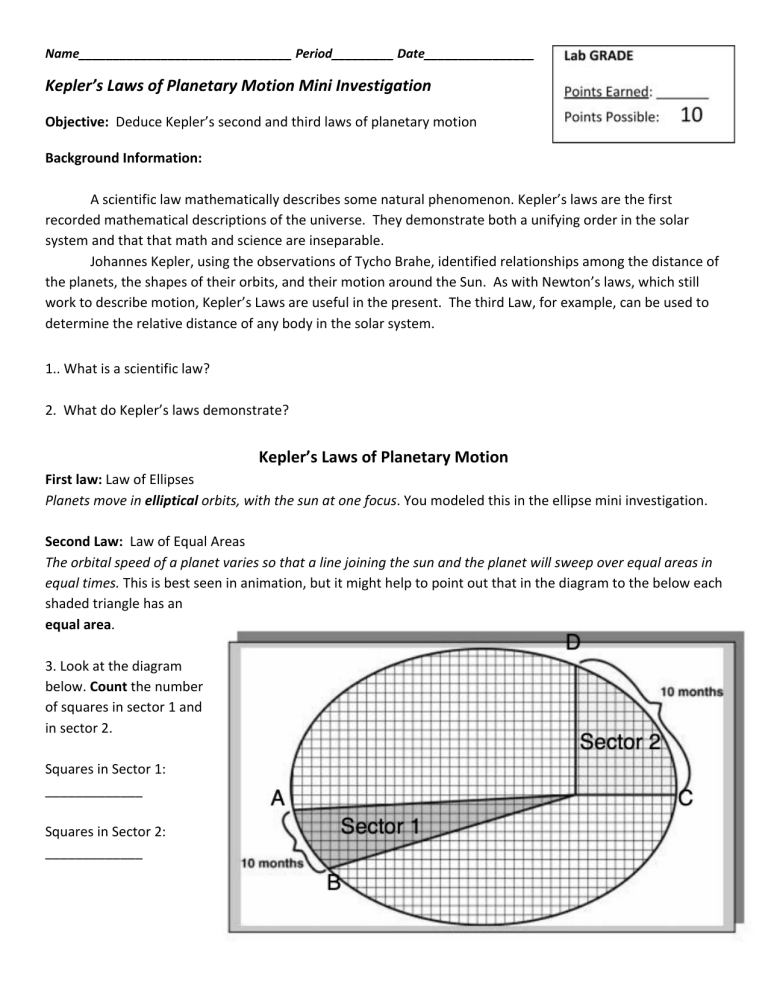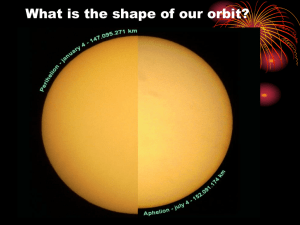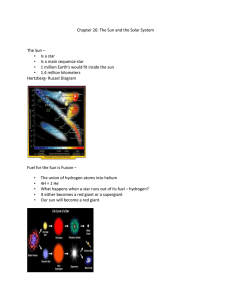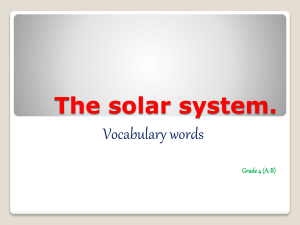
Name_______________________________ Period_________ Date________________ Kepler’s Laws of Planetary Motion Mini Investigation Objective: Deduce Kepler’s second and third laws of planetary motion Background Information: A scientific law mathematically describes some natural phenomenon. Kepler’s laws are the first recorded mathematical descriptions of the universe. They demonstrate both a unifying order in the solar system and that that math and science are inseparable. Johannes Kepler, using the observations of Tycho Brahe, identified relationships among the distance of the planets, the shapes of their orbits, and their motion around the Sun. As with Newton’s laws, which still work to describe motion, Kepler’s Laws are useful in the present. The third Law, for example, can be used to determine the relative distance of any body in the solar system. 1.. What is a scientific law? 2. What do Kepler’s laws demonstrate? Kepler’s Laws of Planetary Motion First law: Law of Ellipses Planets move in elliptical orbits, with the sun at one focus. You modeled this in the ellipse mini investigation. Second Law: Law of Equal Areas The orbital speed of a planet varies so that a line joining the sun and the planet will sweep over equal areas in equal times. This is best seen in animation, but it might help to point out that in the diagram to the below each shaded triangle has an equal area. 3. Look at the diagram below. Count the number of squares in sector 1 and in sector 2. Squares in Sector 1: _____________ Squares in Sector 2: _____________ 1 4. How do the number of squares in Sector 1 compared to the number of squares in Sector 2? What does the number of squares imply about the area of each sector? 5. If it takes the same amount of time for a planet to move from point A to point B as it does for a planet to move from point C to point D, do you think that that the planet travels at the same speed? At what point in its orbit will the planet travel faster? Speed from A to B (faster or slower?) Speed from C to D (faster or slower?) You will use a simulator to model this Law. Click here to access the simulator. 1. Under “orbit settings”, select Mercury and click, “OK.” 2. Below the picture, click Kepler’s second law. Then, adjust the size so the fraction says 1/12. This means that every triangle that will appear will be 1/12 of a year. 3. Click the checkbox that says “sweep continuously,” then click “start sweeping.” According to the Second Law, each of the 12 triangles has an equal area, even though they are different shapes. 6. Now, reset the simulator. Set the controls for Earth, and click OK. Create the colored triangles for Earth. What do you notice about the shapes? Why does this happen? 7. Fill in the blanks below based on what you observed in the simulation. Kepler’s Second Law says that planets sweep out equal _________________ in equal _____________________. To do this, planets _________________ ____ when closer to the Sun and they ____________________ ________ when farther from the Sun. 2 Third LAW: Law of Harmonies The amount of time a planet takes to orbit the sun is related to the size of its orbit. The relationship is: P2 = a3 Where P is the period of revolution in years, and "a" is the length of the semimajor axis or the ellipse in AUs. (Simply put: the farther away a planet, the longer it takes to orbit the Sun) You will use a simulator to model this Law. Click here to access the simulator. 1. Below the picture, click Kepler’s third law. 2. In “visualization options” in lower right corner, check the boxes for “show solar system orbits”, “show solar system planets” and “label the solar system orbits” 3. Under orbit settings, select Mercury, click OK then click “start animation” in the animation controls 4. One at a time, switch to the next planet further out, remembering to click OK after each. 8. What do you notice about the speed at which planets orbit as they move further away from the Sun? Use the chart below to answer the next two questions. 9. How does the distance from the Sun of a planet affect the planet’s orbital velocity? In other words, do planets that are farther from the Sun travel faster or do they travel slower? 10. Based on your response to question #9, what does Kepler’s Third Law of Planetary Motion say? 3 4




